Features & Columns
Thrash Masters
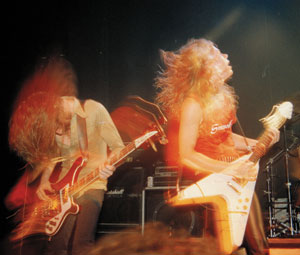 Cliff Burton and James Hetfield of Metallica thrash at the Keystone Palo Alto, Halloween 1983. Photograph by Brian Lew
Cliff Burton and James Hetfield of Metallica thrash at the Keystone Palo Alto, Halloween 1983. Photograph by Brian Lew
IN 1984, Brian Lew operated the first official Megadeth fan club from his parents' house in Sunnyvale. It happened like this: After guitarist/vocalist Dave Mustaine was thrown out of Metallica, he didn't immediately move back to his home turf in SoCal. He couch surfed around the Bay Area while Lew collected Mustaine's mail during the initial stages of his new band, Megadeth.
"He needed some place for the band's mail to go to," Lew recalls. "He really didn't have a mailing address. So I used my parents' house. I made up some Megadeth fan club stationary, people wrote in, and it went on for a year. Once things got going, after the first album came out, he took it back over, but I remember giving him a huge garbage bag filled letters that I had collected. When the band came back to town, I gave him all the letters."
During those halcyon days, Lew and pal Harald Oimoen took loads of pictures—capturing vivid images of thrash bands onstage, backstage, at drinking binges and essentially everywhere else. More than 400 of those pictures now comprise Murder in the Front Row: Shots From the Bay Area Thrash Metal Epicenter, a new volume being released this month accompanied by texts from the photographers and bandmembers themselves.
In Murder in the Front Row, one sees Oimoen's shots from when Metallica played at the Keystone Palo Alto in 1983, as well as Lew's pictures of Exodus performing at Ruthie's in 1984. Likewise at Keystone Palo Alto, we get 1984 shots of Megadeth when Kerry King was in the band. From Berkeley, the books provides shots of Slayer frolicking in the park after a 1984 gig with Suicidal Tendencies.
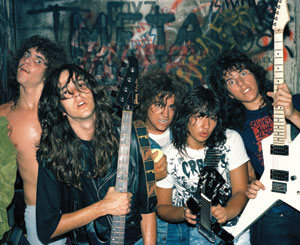 Legacy poses backstage in a graffiti-covered room at Ruthie's Inn in Berkeley, shortly before the band became Testament. Photograph by Harald Oimoen
Legacy poses backstage in a graffiti-covered room at Ruthie's Inn in Berkeley, shortly before the band became Testament. Photograph by Harald Oimoen
The two photographers initially met as teenagers at a 1981 Y&T gig, also at the Keystone Palo Alto. Oimoen worked at the Photo Drive-Up in Sunnyvale, where Lew would often take his pictures to be developed. Before long, the two occupied the front row at every thrash gig in the Bay Area, ensconced in the raging madness of a new and extreme flavor of metal.
During the first half of the '80s, the Bay Area was an unmatched place for heavy metal. The unknown Metallica had just relocated from Los Angeles to gig at places like the Old Waldorf in San Francisco and the Keystone Palo Alto. The New Varsity Theater in Palo Alto drew thrash fans, as did the old Mountain View Theater. In San Jose, a temporary joint called the Stagecoach Inn booked a few thrash shows, and some bands even showed up at the Fencing Center on North First Street.
In the East Bay, the violent slam-dancing and stage-diving that normally characterized punk shows crossed over to metal gigs, beginning at Ruthie's Inn, a gorgeous little booze bin in Berkeley. At Ruthie's, a local metal band, Exodus, prided themselves on their noxious hatred of "poseurs," the ever-growing contingent of glam-metal bands.
Two Los Angeles bands, Slayer and Megadeth, found a more appreciative audience in the Bay Area than they ever did at home, so they started regularly booking gigs in NorCal.
Collectively performing some of the sickest, fastest and most extreme metal anyone had seen, the aforementioned bands, along with subsequent others, essentially turned the Bay Area into the undisputed world capital of what came to be known as thrash metal.
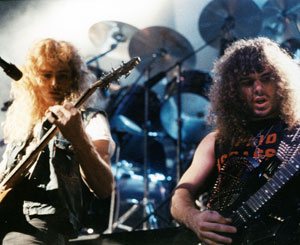 Dave Mustaine (left) and Kerry King of Megadeth at Keystone Palo Alto for an April 16, 1984, show. Photograph by Harald Oimoen
Dave Mustaine (left) and Kerry King of Megadeth at Keystone Palo Alto for an April 16, 1984, show. Photograph by Harald Oimoen
Everyone at the shows knew everybody else. The bands and the fans all got hammered together after every show and the scene was entirely a do-it-yourself endeavor, featuring homemade demo tapes, fanzines and flyers.
Many books have tried to talk about the Bay Area's thrash scene, but Murder in the Front Row is the very first photo documentation that begins at the beginning, rather than the mid-'80s. Lew says that it fills an important gap, especially since many other scenes like punk and grunge are so well documented and photographed.
"For some reason, metalheads in 1983 weren't into documenting everything," Lew tells me. "When people talk about the old punk scenes in their cities, it's always so reverential. When punk stepped in, for whatever reason, they documented their scene way better than other genres. There were more artistic people involved, more people with cameras, scenes like LA punk, grunge in Seattle, all those scenes are so well documented. But with thrash, the only exposure people ever get is the That Metal Show version."
And contrary to what the revisionist folks on That Metal Show might want us to believe, thrash cannot be lumped in the same category as all other metal music of that decade. It was not the Heavy Metal Parking Lot documentary crowd at all. Thrash music was 10 times faster and 10 times heavier and, in that sense, claimed influence from punk bands like GBH, the Exploited and Discharge.
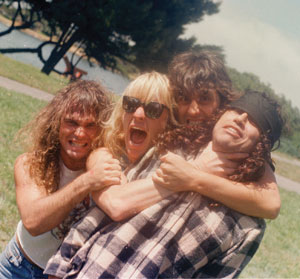 Slayer mobbed Tom Araya, who is decked out like a follower of Suicidal Tendencies in flannel shirt and headband, at Aquatic Park, Aug. 19, 1984. Photograph by Harald Oimoen
Slayer mobbed Tom Araya, who is decked out like a follower of Suicidal Tendencies in flannel shirt and headband, at Aquatic Park, Aug. 19, 1984. Photograph by Harald Oimoen
Rotting Flesh
If one attended thrash shows in those days, the bands themselves were almost always sporting punk shirts. When Metallica, Slayer and Exodus first put albums out, they terrified conventional hard-rock fans. To those fans, thrash was way too close to punk. They didn't get it. And instead of lyrics about booze, broads and cars, thrash lyrics were about murder, Satan, torture, cannibalism, necrophilia, rotting flesh, botched medical procedures and vomiting.
Thrash fans also harbored a toxic hatred for the glam-metal bands of that era, which seems like a trivial dispute now, but at the time, it was all-out war. The glam bands were about Hollywood, rockstardom and pretty-boy imagery. In fact, glam wasn't even metal, really. It was just pop music played by dudes with long hair and lipstick.
Thrash bands and their people, on the other hand, were the everyday outcasts: the skinny runts, the zit-faced dirtheads and the loners in high school who couldn't get laid, didn't know how to talk to girls and went shoulder-tapping for cheap 12-packs and Barcardi 151 at every liquor store across suburbia. And they craved extreme forms of metal. To them, the glam bands represented everything that had gone wrong with music and they needed to be destroyed, beaten and kicked.
"If someone showed up at Ruthie's with a Motley Crue shirt or a Ratt shirt, Paul Baloff [of Exodus] would literally tear that shirt off the person's back," Lew explains. "He and [Exodus guitarist] Gary Holt would tear up the shirts and tie them around their wrists and wear them as trophies. As badges of honor. That was what the original scene was like."
It's true. Baloff would often command the audience to 'sacrifice a poseur,' by throwing the dude onto the stage. The more mainstream types in the crowd would then get nervous.
In the original days, Exodus fans were legendary for destroying venues, and Holt himself supplied one of the texts for Murder in the Front Row. In a screed titled "The Birthplace of Violence," Holt claims Ruthie's Inn was the first place where slam-dancing and stage-diving crossed over from punk shows to metal shows.
Holt writes: "This was the place where the pit really became what it is today. Fist-banging gave way to stage diving and all-around mayhem, due in large part to our crossover audience of metalheads and punks. This was where the shit truly hit the proverbial fan."
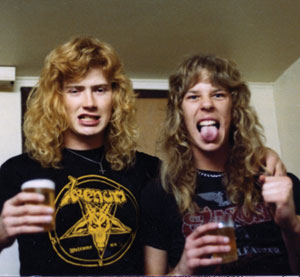 Dave Mustaine (left) and James Hetfield do their best Kiss impression backstage at the Old Waldorf, Nov. 29, 1982, the night Metallica recorded the live demo for 'Metal Up Your Ass.' Photograph by Brian Lew
Dave Mustaine (left) and James Hetfield do their best Kiss impression backstage at the Old Waldorf, Nov. 29, 1982, the night Metallica recorded the live demo for 'Metal Up Your Ass.' Photograph by Brian Lew
In the South Bay, Metallica played a memorable show at the Keystone Palo Alto on Halloween, 1983. Sponsored by San Jose's KOME 98.5 as part of their Metal Monday series, the tickets were $5.98. Lew had a backstage pass, as he had already known the band for a year.
"One thing that's hard for people to wrap their head around is that back then, we were all the same age as the bands," Lew says. "They were just like us. We were all kids, even the bands. There was no line between the band and the fans."
Murder in the Front Row depicts copious amounts of underage drinking. In the early days, many of the bandmembers were not even 21 years of age yet. One sees myriad shots of Metallica, at age 19 or 20, drunk at their house in El Cerrito or hotel rooms or even backstage at clubs.
"That's the way the times were," Lew says. "It was a different world back then. There weren't as many rules and regulations at clubs. The book captures all of that. There's pictures of me and Lars [Ulrich] drinking backstage at the Old Waldorf, and we were just 18. That's an aspect hard for people now to wrap their heads around. Before these bands became iconic, they were just our friends. At the time, we didn't have to arrange to meet the bands, we just went and hung out."
'Murder in the Front Row: Shots From the Bay Area Thrash Metal Epicenter.'
By Harald Oimoen & Brian Lew; Bazillion Points; $39.95


